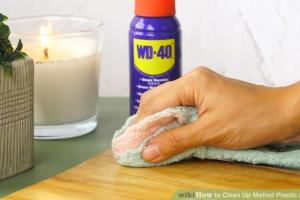Ultimate Guide to Cleaning Melted Plastic and Wax: Tips & Techniques

-
Quick Links:
- Introduction
- Understanding the Problem
- Safety Precautions
- How to Clean Melted Plastic
- How to Clean Wax
- Case Studies
- Expert Insights
- Conclusion
- FAQs
Introduction
There are few household accidents more frustrating than discovering melted plastic or wax on your favorite surfaces. Whether it's from a candle left unattended or a plastic item that has met a hot surface, these substances can seem nearly impossible to remove. This comprehensive guide will explore the best methods for cleaning up melted plastic and wax, helping you restore your surfaces to their original condition.
Understanding the Problem
Melted plastic and wax can both create unsightly stains and potentially damage surfaces. Understanding their properties can help you devise the best cleaning strategies.
- Melted Plastic: Plastic can bond with surfaces and may require different techniques depending on the material of the surface affected.
- Melted Wax: Wax can be easier to remove due to its composition but can still leave marks and residues that need addressing.
Safety Precautions
Before embarking on your cleaning journey, it's essential to take some safety measures:
- Wear gloves to protect your skin.
- Ensure the area is well-ventilated, especially if using solvents.
- Keep a fire extinguisher nearby if working with heat sources.
- Test cleaning solutions on a small, inconspicuous area first.
How to Clean Melted Plastic
Cleaning melted plastic requires careful handling to avoid further damage. Follow these steps:
Step 1: Identify the Surface
Different surfaces (wood, carpet, tile) require different approaches. Understand your surface material before proceeding.
Step 2: Freeze Method
A popular method for cleaning melted plastic involves freezing:
- Place ice cubes in a plastic bag and apply it to the melted plastic.
- Wait for 10-15 minutes until the plastic hardens.
- Gently scrape off the hardened plastic using a plastic scraper or a credit card.
Step 3: Heat Method
If freezing doesn’t work, you can try the heat method:
- Set a hair dryer on low heat and direct it at the plastic.
- As the plastic softens, use a scraper to remove it carefully.
- Wipe the area with a cloth to remove any residue.
Step 4: Using Solvents
For stubborn residues, you may need a solvent:
- Apply rubbing alcohol or adhesive remover to a cloth.
- Gently rub the affected area.
- Clean the area with warm soapy water afterward.
How to Clean Wax
Cleaning wax is often simpler than plastic due to its different properties. Here’s how to do it:
Step 1: Allow to Cool
Let the wax cool and harden for easier removal.
Step 2: Scrape Off Excess Wax
Use a plastic scraper or credit card to remove as much wax as possible without scratching the surface.
Step 3: Heat the Area
To remove any remaining wax:
- Place a paper towel over the remaining wax.
- Use an iron set to low heat and press it over the towel.
- The wax will melt and absorb into the towel.
Step 4: Clean Residue
After removing the wax, clean the area with soapy water or a suitable cleaner to remove any leftover residue.
Case Studies
Let’s look at a few real-world examples of how individuals successfully cleaned melted plastic and wax:
Case Study 1: Kitchen Countertop
A homeowner discovered melted plastic from a hot pan on their granite countertop. They used the freezing method successfully to remove the plastic without damaging the surface.
Case Study 2: Carpet Wax Stain
Another individual faced a wax spill on a carpet. They utilized the paper towel and heat method, achieving impressive results without harming the fabric.
Expert Insights
We spoke with cleaning experts to gather their insights on the best practices for dealing with melted plastic and wax:
- “Always test your cleaning method on a small area first,” advises Jane Smith, a professional cleaner.
- “Prevention is key. Use coasters and heat-resistant mats to avoid incidents,” suggests Mike Johnson, a home improvement expert.
Conclusion
Cleaning melted plastic and wax can seem daunting, but with the right techniques and precautions, you can restore your surfaces effectively. Remember to always test methods on inconspicuous areas and prioritize safety throughout the cleaning process.
FAQs
1. Can I use heat on all surfaces?
No, avoid using heat on sensitive surfaces like plastic or painted areas.
2. What is the best solvent for melted plastic?
Rubbing alcohol or adhesive removers are generally effective.
3. Is it safe to use a hairdryer for cleaning?
Yes, but keep it at a low setting to avoid damage.
4. How do I clean wax from upholstery?
Use the paper towel and heat method, but be careful with the fabric.
5. Can I use vinegar for cleaning melted wax?
Vinegar may help, but it is not as effective as heat methods.
6. What tools do I need for cleaning melted plastic?
A plastic scraper, cloths, and possibly a hairdryer or ice pack.
7. How can I prevent wax spills in the future?
Use candle holders and never leave burning candles unattended.
8. What surfaces can be damaged by melted plastic?
Wood, certain plastics, and painted surfaces can be particularly vulnerable.
9. Can I use an iron on my carpet?
Yes, but use a low setting and a protective layer like a paper towel.
10. Are there professional services for cleaning?
Yes, many cleaning services specialize in stain removal from various surfaces.
Random Reads
- How to remove dead animal odor
- How to remove contact paper
- Connect smart tv to wifi
- Connect ps5 hotel wifi
- How to type letters with accents
- How to type pi symbol
- How to fix exposed electrical wire
- How to fix computer speakers
- How to gain entrance to sky haven temple in skyrim
- How to set up and use bluetooth devices with iphone